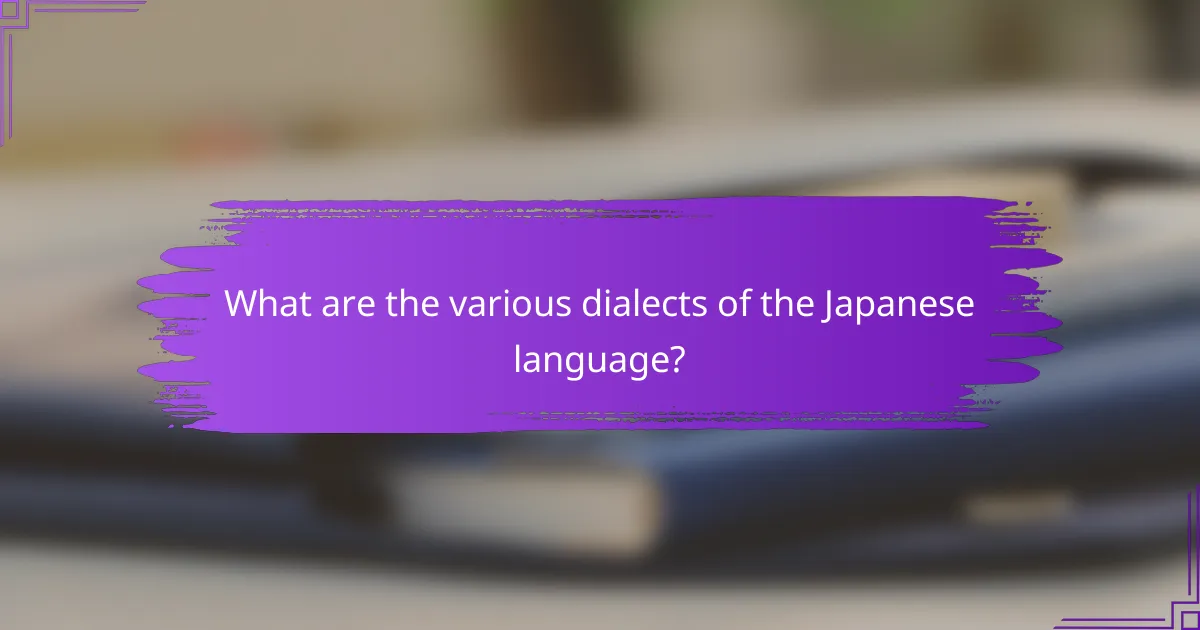
What are the key features of the Japanese language?
The key features of the Japanese language include its unique writing systems, grammar structure, and honorifics. Japanese uses three scripts: Kanji, Hiragana, and Katakana. Kanji consists of logographic characters borrowed from Chinese. Hiragana is a phonetic script used for native words and grammatical elements. Katakana is also phonetic, primarily used for foreign words and names.
The grammar of Japanese is characterized by its subject-object-verb (SOV) order. This structure influences sentence construction and meaning. Additionally, Japanese employs particles to indicate grammatical relationships. These particles play a crucial role in understanding context.
Honorifics are an essential aspect of Japanese language and culture. They reflect social hierarchy and relationships between speakers. The use of polite forms is common in daily conversation.
Overall, these features contribute to the complexity and richness of the Japanese language.
How does the structure of the Japanese language differ from other languages?
The structure of the Japanese language differs significantly from many other languages. Japanese employs a subject-object-verb (SOV) order, unlike the subject-verb-object (SVO) order common in English. This means that in a typical Japanese sentence, the verb comes at the end. Additionally, Japanese uses particles to indicate grammatical relationships, which is less common in many languages. For example, the particle “” (wa) marks the topic of a sentence, while “” (o) indicates the direct object.
Japanese also incorporates honorifics that reflect social hierarchy, impacting verb forms and vocabulary. This is a unique feature not found in many Western languages. Furthermore, the language has three writing systems: kanji, hiragana, and katakana, which function together in a single sentence. This multi-script usage is distinct from languages that rely on a single script. Overall, these structural elements create a unique linguistic environment in Japanese.
What are the main components of Japanese grammar?
The main components of Japanese grammar include particles, verbs, nouns, and adjectives. Particles indicate the grammatical function of words in a sentence. For example, “” (wa) marks the topic, while “” (wo) marks the direct object. Verbs in Japanese indicate actions and are conjugated to reflect tense and politeness. Nouns serve as subjects or objects and can be modified by adjectives. Adjectives describe nouns and can also be conjugated. Together, these components create meaning and structure in Japanese sentences.
How do particles function in Japanese sentences?
Particles in Japanese sentences serve as grammatical markers that indicate the relationship between words. They define the role of nouns and phrases, such as subjects, objects, and locations. For example, the particle “” marks the subject, while “” indicates the direct object. The particle “” specifies direction or time, and “” denotes the location of an action. Each particle helps clarify meaning and structure within a sentence. Their correct usage is essential for conveying precise information. Understanding particles is fundamental for mastering Japanese grammar.
What role do kanji, hiragana, and katakana play in Japanese writing?
Kanji, hiragana, and katakana are essential components of Japanese writing. Kanji represents words or concepts and originates from Chinese characters. Hiragana is a phonetic script used for native Japanese words and grammatical elements. Katakana serves a similar phonetic purpose but is primarily used for foreign words and names. Together, these scripts create a comprehensive writing system. The combination allows for nuanced expression in the language. For example, kanji can convey meaning, while hiragana and katakana provide phonetic clarity. This multi-script system enhances the richness and flexibility of written Japanese.
How does the use of kanji enhance meaning in the language?
Kanji enhances meaning in the Japanese language by providing context and nuance. Each kanji character represents a specific meaning or concept. This allows for more precise communication than using only phonetic scripts like hiragana or katakana. For example, the kanji for “tree” () conveys a clear image and concept. In contrast, the phonetic representation does not carry the same visual or conceptual weight. Additionally, kanji can combine to form compound words, adding layers of meaning. For instance, the combination of (tree) and (forest) creates (forest), illustrating a complex idea succinctly. The historical use of kanji also enriches the language’s cultural context. Kanji often reflects the origins of words and concepts, linking modern language to historical roots. This depth of meaning supports more expressive and varied communication.
What are the differences in usage between hiragana and katakana?
Hiragana and katakana are both syllabaries used in the Japanese writing system. Hiragana is primarily used for native Japanese words and grammatical elements. Katakana, on the other hand, is used for foreign words, loanwords, and onomatopoeia. Hiragana appears in most Japanese texts, while katakana is often reserved for specific contexts. For instance, katakana is used for the names of plants, animals, and scientific terms. Hiragana is also used in children’s literature and for furigana, which indicates pronunciation. Each syllabary consists of 46 basic characters. Hiragana is more fluid and cursive, while katakana has a more angular appearance. This distinction helps readers quickly identify the context of words in written Japanese.

How do cultural nuances influence Japanese expressions?
Cultural nuances significantly influence Japanese expressions by shaping their meaning and usage. Language in Japan is deeply intertwined with social hierarchy and context. Politeness levels vary based on the relationship between speakers. For example, honorifics are used to show respect, reflecting cultural values. Additionally, indirect expressions are common, often conveying meaning beyond the literal words. Contextual factors, such as setting and audience, further affect expression choices. Historical events and traditions also play a role in shaping language. These elements create a rich tapestry of communication that reflects Japanese cultural identity.
What are some common expressions unique to Japanese culture?
Common expressions unique to Japanese culture include “Itadakimasu” and “Gochisousama deshita.” “Itadakimasu” is said before meals to express gratitude for the food. This phrase reflects respect for the ingredients and those who prepared the meal. “Gochisousama deshita” is said after eating to thank the cook. It signifies appreciation for the meal enjoyed. Another expression is “Wabi-sabi,” which conveys the beauty of imperfection and transience. This concept is deeply rooted in Japanese aesthetics and philosophy. “Kawaii” means cute and is a significant cultural phenomenon in Japan. It reflects a societal admiration for innocence and charm. Each of these expressions carries cultural significance and illustrates Japanese values and social norms.
How do honorifics shape interpersonal communication in Japan?
Honorifics significantly shape interpersonal communication in Japan by establishing social hierarchy and respect. They reflect the relationship between speakers, indicating status and familiarity. For instance, using “-san” shows respect, while “-kun” or “-chan” indicates familiarity or affection. The choice of honorific can alter the tone of a conversation. In business settings, using appropriate honorifics is crucial for professionalism. Misusing honorifics can lead to misunderstandings or perceived disrespect. This linguistic practice is deeply rooted in Japanese culture, influencing daily interactions. Honorifics also facilitate smooth communication by signaling social roles. Overall, they are essential for maintaining harmony in social exchanges.
What are some idiomatic expressions that reflect Japanese values?
Some idiomatic expressions that reflect Japanese values include “Ichi-go ichi-e,” which means “one time, one meeting.” This phrase emphasizes the importance of cherishing each moment and encounter. Another expression is “Wa” (), which signifies harmony and the value placed on group cohesion. Additionally, “Ninjo” () refers to human feelings and compassion, highlighting the importance of empathy in relationships. These expressions encapsulate core Japanese values such as mindfulness, community, and emotional connection.
Why is context important in understanding Japanese expressions?
Context is crucial in understanding Japanese expressions because it influences meaning and interpretation. Japanese language relies heavily on situational context, social hierarchy, and cultural nuances. For example, the same expression can convey different meanings depending on the relationship between speakers. Additionally, certain phrases may be polite or informal based on context. Understanding these layers is essential for accurate communication. Research shows that misinterpretation often occurs when context is overlooked. The complexity of Japanese expressions highlights the need for contextual awareness in language use.
How does the concept of ‘wa’ (harmony) affect communication styles?
The concept of ‘wa’ (harmony) significantly influences communication styles in Japanese culture. It encourages indirect communication to maintain group harmony and avoid conflict. People often use non-verbal cues and subtle hints rather than direct statements. This approach fosters a sense of unity and respect among individuals. The emphasis on harmony can lead to avoidance of confrontational topics. Additionally, it shapes the use of honorific language to show respect and consideration. Studies indicate that this communication style is deeply rooted in historical and social contexts. For example, the importance of ‘wa’ can be traced back to Confucian values that prioritize social cohesion.
What are some examples of context-dependent phrases in Japanese?
Context-dependent phrases in Japanese include expressions that change meaning based on the situation. One example is “” (otsukaresama desu), which conveys appreciation for someone’s hard work. Another example is “” (yoroshiku onegaishimasu), which can mean “please treat me well” or “thank you in advance,” depending on context. Additionally, “” (sumimasen) can express apology or gratitude based on the interaction. These phrases demonstrate how context shapes meaning in Japanese communication.

What are the various dialects of the Japanese language?
The various dialects of the Japanese language include Kansai, Kanto, Hokkaido, and Kyushu. Kansai dialect is spoken in the western part of Honshu, including cities like Osaka and Kyoto. Kanto dialect is prevalent in the eastern region, particularly in Tokyo. Hokkaido dialect is found in the northernmost island of Japan. Kyushu dialect is common in the southern island of Kyushu. Each dialect has unique phonetic, lexical, and grammatical features. For example, Kansai dialect is known for its distinct intonation and vocabulary. The diversity of these dialects reflects regional cultural differences within Japan.
How do regional dialects differ within Japan?
Regional dialects in Japan, known as “hōgen,” vary significantly across different regions. Each dialect has unique phonetic, lexical, and grammatical features. For instance, the Kansai dialect is known for its distinct intonation and vocabulary, differing from the standard Tokyo dialect. In contrast, the Tohoku dialect features unique pronunciation patterns and vocabulary that can be challenging for non-locals to understand. Additionally, dialects like the Okinawan language are so distinct that they are considered separate languages. Historical factors, such as isolation and cultural influences, contributed to these variations. Each regional dialect reflects the local culture and identity, showcasing Japan’s linguistic diversity.
What are the characteristics of the Kansai dialect?
The Kansai dialect is characterized by its distinct intonation and vocabulary. It is spoken in the Kansai region, including cities like Osaka and Kyoto. One notable feature is the use of a rising intonation at the end of sentences, which conveys a friendly tone. Vocabulary differences include unique words and phrases not found in standard Japanese. For example, “akan” means “no good” in Kansai dialect. Additionally, Kansai speakers often use informal speech patterns. The dialect is also known for its humor and lively expressions. These characteristics contribute to its cultural identity and social interactions in the region.
How does the Tohoku dialect reflect local culture and identity?
The Tohoku dialect reflects local culture and identity through its unique vocabulary and pronunciation. It incorporates words and expressions that are specific to the Tohoku region. This dialect conveys the history and traditions of the local people. For example, certain terms are derived from agricultural practices common in Tohoku. The dialect also embodies the community’s resilience and pride, especially after the 2011 earthquake. Additionally, the use of the dialect fosters a sense of belonging among residents. Studies show that regional dialects, like Tohoku, strengthen local identity and cultural ties. The distinct intonation patterns further differentiate it from standard Japanese, reinforcing regional uniqueness.
Why is it important to understand dialect variations in Japanese?
Understanding dialect variations in Japanese is crucial for effective communication. Japan has numerous dialects, each with unique vocabulary, pronunciation, and grammar. These variations can affect meaning and context in conversations. Misunderstandings may arise if one is unfamiliar with a specific dialect. Additionally, dialects reflect cultural identity and regional history. Recognizing these differences fosters deeper connections with native speakers. It enhances language learning by providing context and nuance. In professional settings, understanding dialects can improve collaboration and reduce miscommunication.
How can dialect awareness improve communication with locals?
Dialect awareness enhances communication with locals by fostering mutual understanding. It allows individuals to recognize and respect regional variations in language. This recognition helps avoid misunderstandings that can arise from different dialects. Additionally, it builds rapport and trust between speakers. Research indicates that people are more receptive to those who use familiar dialects. A study published in the Journal of Language and Social Psychology found that dialect alignment increases perceived social closeness. Overall, being aware of dialects leads to more effective and meaningful interactions.
What are some challenges faced by learners of Japanese dialects?
Learners of Japanese dialects face several challenges. One major challenge is the significant variation in vocabulary and expressions. Different regions use distinct terms that may not be understood by speakers from other areas. Pronunciation differences also pose a challenge. Dialects can have unique phonetic features that are difficult for learners to master. Grammar variations can create confusion as well. Some dialects may have different grammatical structures or usages compared to standard Japanese. Cultural context is another hurdle. Understanding local customs and references is essential for effective communication. Additionally, exposure to dialects can be limited. Many learners primarily study standard Japanese, leaving them unprepared for dialectal nuances. These challenges make learning Japanese dialects a complex task.
What practical tips can help in mastering Japanese language and cultural nuances?
To master the Japanese language and cultural nuances, immerse yourself in the language daily. Practice speaking with native speakers to enhance pronunciation and fluency. Utilize language learning apps like Duolingo or Anki for vocabulary building. Watch Japanese films and anime to understand cultural context and expressions. Read books or manga to familiarize yourself with different dialects and writing styles. Attend language exchange meetups to practice conversational skills. Learn keigo, or honorific language, to navigate social hierarchies effectively. Understanding cultural references and idiomatic expressions is crucial for effective communication.
How can immersion experiences enhance understanding of expressions and dialects?
Immersion experiences enhance understanding of expressions and dialects by providing direct interaction with native speakers. This interaction allows learners to hear and practice authentic pronunciation and intonation. Additionally, immersion exposes learners to cultural contexts that shape language use. For example, idiomatic expressions often rely on cultural references. Engaging in real-life conversations helps learners grasp these nuances. Research indicates that immersion can lead to better retention of language skills. A study by the Center for Applied Linguistics found that immersion students outperform their peers in language proficiency. Overall, immersion experiences create a rich environment for language acquisition.
What resources are recommended for learning Japanese cultural context effectively?
Books, documentaries, and online courses are recommended resources for learning Japanese cultural context effectively. “The Book of Tea” by Okakura Kakuzō explores the philosophy behind Japanese tea culture. “Japanese Culture: A Short History” by John W. Dower provides insights into historical influences on modern Japan. Documentaries like “Jiro Dreams of Sushi” highlight culinary traditions and cultural values. Online platforms such as Coursera and edX offer courses on Japanese culture, often created by reputable universities. Engaging with native speakers through language exchange apps can also deepen cultural understanding.
The main entity of this article is the Japanese language, focusing on its unique features, grammar, and cultural nuances. Key topics include the three writing systems—Kanji, Hiragana, and Katakana—along with the subject-object-verb (SOV) grammatical structure and the role of honorifics in communication. The article also explores dialect variations across regions, emphasizing how they reflect local culture and identity. Additionally, it discusses the importance of context in understanding expressions and provides practical tips for mastering the language and its cultural intricacies.